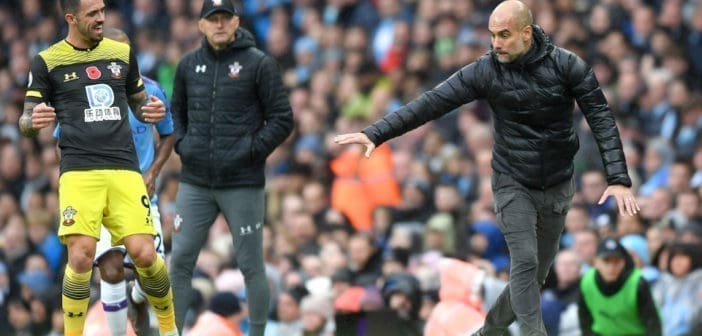I must warn you, this is not a fiction of fantasy or a piece entitling delusion, It is December 2020 and there is a genuine debate to be had.
In all fairness, this discussion had never carried legs prior to this season. Have Southampton now become aesthetically more pleasing than Manchester City?
Pep Guardiola is a footballing architect, one of the fine few from any era that holds the virtuoso genius to brush strokes of artistry to his heavenly crystallised playing canvas. Guardiola’s brand of football has long characterised the entire sport in general, where the days of meat and two veg football has been enveloped by rhythmic passing and multi-faceted tactical configurations.
Guardiola’s Barcelona team transcended the belief of how football should be played. He then reinvented the wheel again at Bayern Munich and Manchester City. But like anything in life, football evolves in cycles and modern ideas suddenly become outdated ones.
So, with all that being said, is Pep Guardiola’s football currently more or less alluring than Ralph Hasenhuttl’s?
After winning successive league titles in the 2018/19 season, Manchester City’s evolution has shuddered to an abrupt halt. Whether it’s their methodology becoming stale or players becoming unresponsive to implementing new ideas, it is clear that Guardiola’s powers of talent extraction is waning.
Here is why.
No David Silva. Firstly, City’s creativity problems have deepened after the departure of Silva at the end of last season. Guardiola’s decided against replacing him in the summer window, meaning there is a void of inspiration in the left-sided channel of Guardiola’s 4-3-3 system, where the Spaniard so richly operated in. Phil Foden was deemed the successor but those plans are currently at an impasse. Instead, the City boss has been moonlighting the 20-year-old as an inverted winger or a false 9.
Silva’s unique gift of retaining possession in order to control the flow of games has been sorely missing. City are now unable to stranglehold opponents and manage key game situations, both of which has led to a palpable vulnerability within.
City’s inability to harness the varying rhythms of a game to preferable levels has meant Guardiola has opted for two holding midfielders, as opposed to the more offensive approach of two further advanced midfielders. Guardiola’s notorious preference for 4-3-3 has been bartered for a substantially more robust, if less inspiring, variation of a 4-2-3-1 system.
Still, City are unable to put a foot in as frequently and effectively as they did in previous Guardiola seasons. The label that City is an unssertive, feeble unit is fortified by their tackles made total this season. In a footballing era that craves high-octane pressing and risk-taking to make vital ball engagements, Manchester City have made the second fewest tackles of any side in the league, with 144 completed. Only Aston Villa – who have the caveat of playing catch up with the rest of the league in fixtures played – have made less (126).
All of which has contributed to a sense of pragmatism within City’s play. They are ostensibly fearful of possessional turnovers and team’s that possess the potency of countering as breakneck speed against their high and highly vulnerable backline.
It is not being helped that oppositions are now being presented with greater chances to counter, due to City no longer having have the steadfast defensive shield of Fernandinho consistently in front of them, nor the control of David Silva to keep things tight and ticking.
In Guardiola’s first four seasons, only Kevin De Bruyne (298) had created more chances the David Silva (231). With Sergio Aguero absent for the majority of the campaign, they are without that murderous edge in and around the box, which was simply a given during the initial trophy-laden years. Unsurprisingly, attacking metrics underline Aguero’s importance to Guardiola’s City reign. The Argentinian has proven to be the most clinical player during that period, scoring 54 per cent of big chances created.
Aguero’s replacements have been judged only marginally sufficient. Aguero’s ruthless streak has been lost and exchanged with long-serving understudy Gabriel Jesus squandering the second most chances of any player in the squad. The Brazilian has missed 26 chances, with a conversion rate of 27.78 percent – a sharp decline on Aguero’s proficient statistics.
The buck now stops with De Bruyne as the side’s primary source of creation. The farewell of David Silva has placed an even heavier burden to manufacture much of City’s attacking patterns. However, due to last season’s truncated schedule, De Bruyne only had eight days rest between last campaign to this one. Therefore, it would be worthwhile to suggest the Belgian’s fluctuating energy and performance levels can be largely attributed to mental and physical fatigue.
With all that being said, perhaps it is little wonder Southampton are outperforming Manchester City in the goalscoring department, despite the vast schism in financial might.
Saints have scored 25 goals in 13, equating to 1.93 per game. But those numbers can be classed as a slight anomaly, given the relatively small amount of shots taken.
Ralph Hasenhuttl’s side have attempted the 12th most shots (147), suggesting they are, by some distance, the league’s biggest overachievers in taking their chances. But explanations to those figures can be obtained thanks to James Ward-Prowse’s downright salacious free-kicks and Danny Ings remarkable finishing.
Just take
Saints’ 4-3 victory over Aston Villa in November as the perfect microcosm to that notion. Three out the four goals defied the expected goals rate – two quintessential Ward-Prowse free-kicks and a curling thunderbolt from Ings.
For big chances missed, Southampton have missed as few as 10 glaring opportunities, putting them a lowly, yet quietly brilliant, 17th on the list.
Meanwhile, Manchester City have scored 18 goals in 12 games, which gives them a healthy, but perhaps unfulfilling rate of 1.5 goals per game. A combination of poor finishing and a striking force that usually breeds on a recurrent production line that’s now been slowed, is failing to seize on the chances that do arrive at sporadic times. City lead the way for big chances missed, with 22 in 12 games.
Despite Saturday’s visitors having played one game less than Saints, they have completed more than a thousand passes more. Southampton’s total of 6693 shows though they remain comfortable on the ball, each pass carries more meaning and progression behind it. Hasenhuttl repeatedly implores his side to look for fast, vertical passes through the thirds, when it is the correct time to do so.
City are third for passes (7787) which is no revelation considering this has long been a staple of the Guardiola football brand.
Both sides are not overly crossing-heavy teams with Southampton 18th and Manchester City 15th, respectively. Saints’ 178 crosses attempted is largely down to the full-backs tendency to only play balls into the box when there is a probable chance of their cross being latched on to. The 4-2-2-2 system means most of their play is funnelled through central areas of the pitch, with more refined passing patterns combined with oscillating rhythms of play coming centrally.
City have made 25 more crosses in a game less. While their tactical set-up lends itself to expansive wide play, it doesn’t currently quite have the same incision or darting runs to make it purposeful.
Irrespective of Manchester City’s almost certain possessional dominance on Saturday, what really matters is which side makes better use of the ball. Will City continue taking long d-tours with it or will Southampton’s natural inclinations to play through the thirds with vigour pose just as much or even greater threat?
Right now, the Southampton playbook is brimming with ideas. Intensity of press, quality and rhythmic offensive patterns. City’s, on the other hand, is looking a little threadbare and has perhaps seen better days. Though no doubt lingers over which side has the better individual quality, in terms of entertainment, captivating football and shuddering energy, the team’s are much more evenly matched.
![Prost International [PINT]](https://prostinternational.com/wp-content/uploads/2021/08/PINTtFontLogoRoboto1536x78.jpg)



